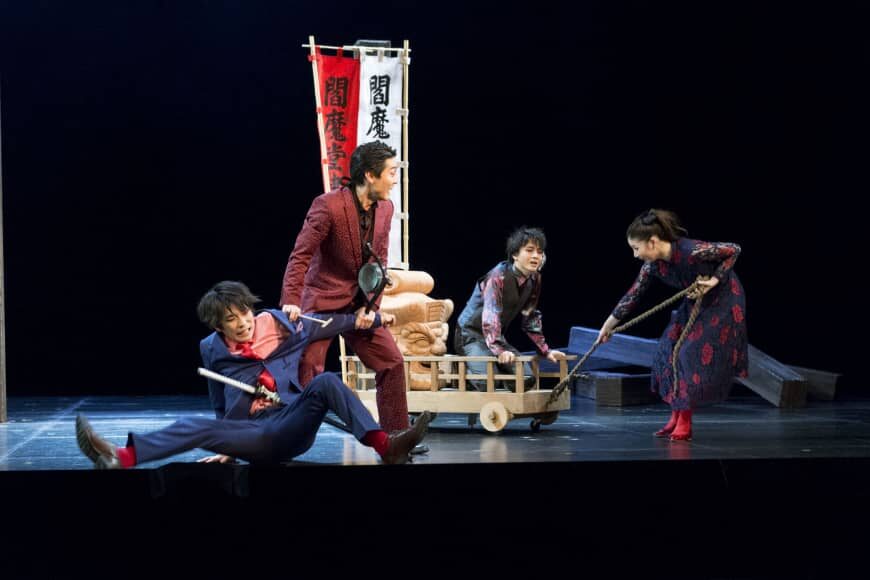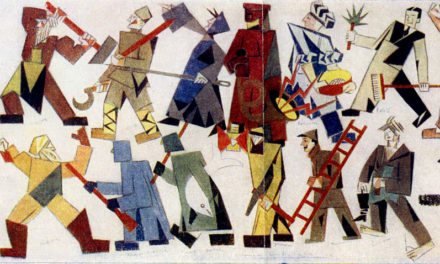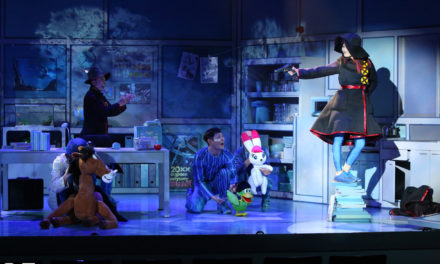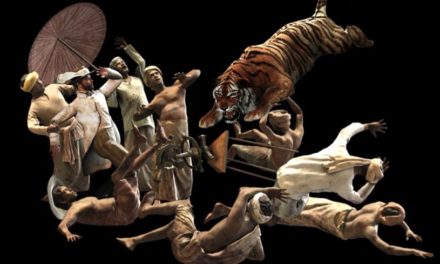For many people, the mention of kabuki brings to mind images of exaggerated makeup on actors’ white-painted faces, beautiful kimono costumes and colorful sets with dramatic backdrops.
Then there are the distinctive standardized movements; classic poses (mie) expressing certain emotions; the precisely choreographed fights and swordplay (tachimawari); and styles of acting (kata), which are passed down through the generations of each family of performers.
In contrast, few people have likely heard of the Kinoshita-Kabuki company founded in 2006 in Kyoto, the birthplace of the traditional performing art some four centuries ago.
Now attracting an ever-growing audience, the troupe adheres to almost none of kabuki’s myriad styles and rules—least of all the insistence on male actors playing the female roles.
Yet, despite its plays being staged by contemporary theater directors, often with simple sets and actors in modern clothes, Kinoshita-Kabuki’s works are invariably faithful to the essence of the dance-dramas and their stories. That same DNA remains, even amid high-tech lighting, sound, and visuals—and modern jargon that helps to address current issues for today’s audiences.
Following the recent Kyoto premiere of the company’s latest work, an interpretation of The Daughter Of Tsuji (Sesshu Gappo ga Tsuji), a 1773 bunraku text by Sensuke Suga and Fuemi Wakatake that became a kabuki play soon after—which runs from March 14-17 at Kanagawa Arts Theatre in Yokohama—its founder, Yuichi Kinoshita, talked about his aims in transforming one of Japan’s traditional performing arts.
“My company has a very unique style,” the 33-year-old begins, as we chat before a rehearsal. “Firstly, I am not a playwright or director; I am leading as a dramaturg (literary advisor and editor).
“Secondly, we appoint young contemporary theater directors for each production and many of the actors on the same basis. That’s because we want to be an open place where different people think about today’s kabuki together,” he says in a gentle Kyoto accent.
A graduate of the performing arts department at Kyoto University of Art & Design, Kinoshita says he’d always thought about how he could bridge his love of both contemporary theater and traditional forms such as kabuki, noh, kyogen (classical comic drama) and bunraku (traditional puppet theater).
“In Western countries, you can’t avoid trying to stage classics such as Shakespeare or Greek tragedies if you want to be a professional director. Also in Japan, many dramatists work more on updating Shakespeare’s plays than tackling our own classics,” he says.
“As I wondered about that, I think I came to understand the reason,” Kinoshita adds. “First of all, our modern theater started after the Meiji Restoration in 1868 with the sudden arrival of plays from Western countries. The current of traditional theater then stopped and its development halted, while the style of Western plays gave impetus to what has become Japanese contemporary theater.
“For instance, even classics like Shakespeare were modernized to some extent when they were translated and performed, so they were more flexible and trouble-free for dramatists here than having to stick rigidly to old Japanese texts.”
Explaining why he started his company, he says, “Traditional theater in Japan is handed down virtually unchanged through performers’ families, and many people love it being that way. So that’s a big hurdle if you present a spinoff in a different style—and you need a good reason to try and do it.
“My reason was, and is, to mix up two separate groups of audiences so they overlap: theater lovers and kabuki fans.”
In practice, he hopes the younger people in his audiences, who have likely never set foot in any of Japan’s venerable kabuki theaters, will be inspired to sample their mainstream fare.
Conversely, he says he would love it if regular kabuki fans venturing to one of his performances then wanted to check out other modern works.
“I basically see myself as an interpreter working with contemporary theater directors to adapt old kabuki scripts for today’s audiences,” he says. “So I try to explain their cultural background to them and our actors, as well as some of the old words and expressions they use.”
This time, Kinoshita has enlisted the 41-year-old theater composer and director Yukinosuke Itoi to jointly create an original version—complete with music and vocals—of The Daughter Of Tsuji.
In this story, the central character is Shuntokumaru (played by Shunji Tagawa), a feudal lord’s handsome son who is resented by his half-brother, Jiromaru (Masahiro Oishi), a son of his father’s mistress.
Following the death of Shuntokumaru’s mother, his father’s new young wife, Tamate Gozen (Chika Uchida), becomes especially fond of him. Then one day he is stricken by a mysterious illness that blinds him and disfigures his face. After that, he leaves home and lives as a beggar until Tamate Gozen tracks him down and the awful truth about what really happened is revealed.
For this production, Itoi—who is famous for his soulful, melodic songs with catchy lyrics—has created a touching drama amid what looks like prehistoric wooden pillars. In this atmospheric setting, the characters hail in song the eternal cycles of the stars, even as their earthly tragedy unravels.
Explaining what drew him to this play, Kinoshita says, “I think it suggests that people lose—not gain—many things through their lives. Shuntokumaru loses his eyesight, and Tamate Gozen even more, but those who remain continue with their lives. So it’s like a snapshot of the universe in which galaxies are born and disappear one after another.”
Back in present-day Japan, meanwhile, Kinoshita-Kabuki is rapidly becoming a star of the contemporary theater scene—a development Kinoshita finds conflicting.
“I feel a bit uncomfortable when I hear that our interpretation of a play is totally correct, and we are the saviors of old kabuki. Actually, our productions are contemporary theater, and they should be among hundreds of different ways of performing those texts,” he says.
“So I’m now looking forward to many more neo-kabuki approaches and styles emerging in the future.”
The Daughter Of Tsuji runs from March 14 to 17 at Kanagawa Arts Theatre in Yokohama. For details, visit www.kaat.jp or kinoshita-kabuki.org.
This post was written by the author in their personal capacity.The opinions expressed in this article are the author’s own and do not reflect the view of The Theatre Times, their staff or collaborators.
This post was written by Nobuko Tanaka.
The views expressed here belong to the author and do not necessarily reflect our views and opinions.


















